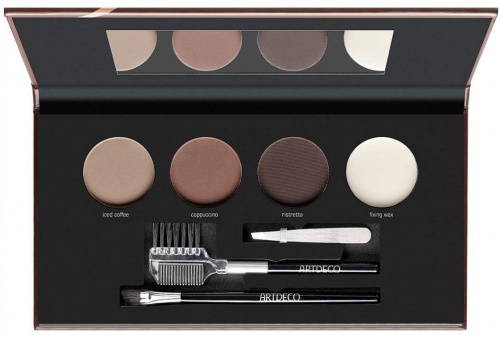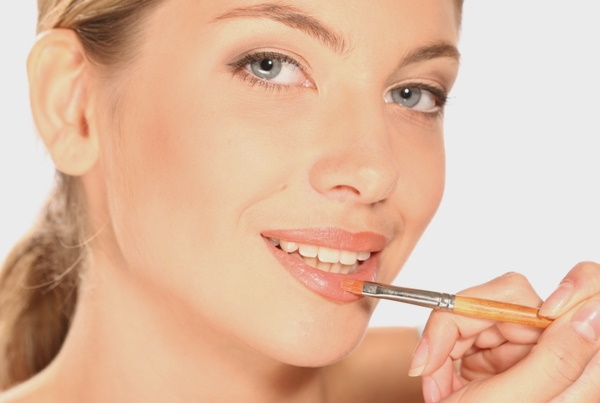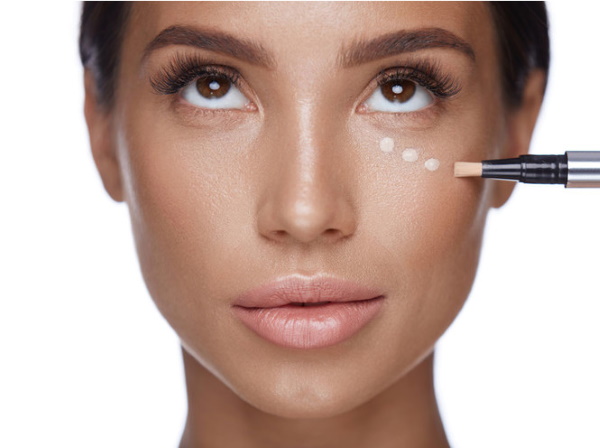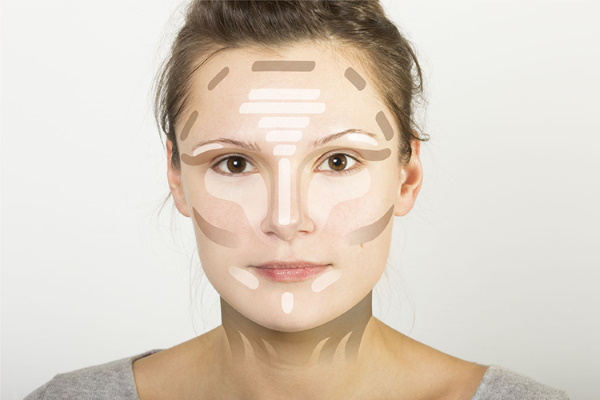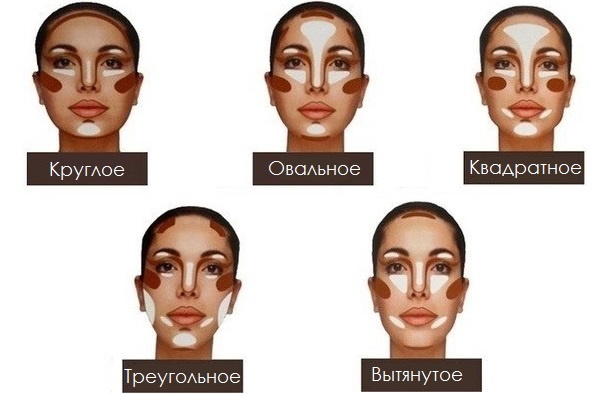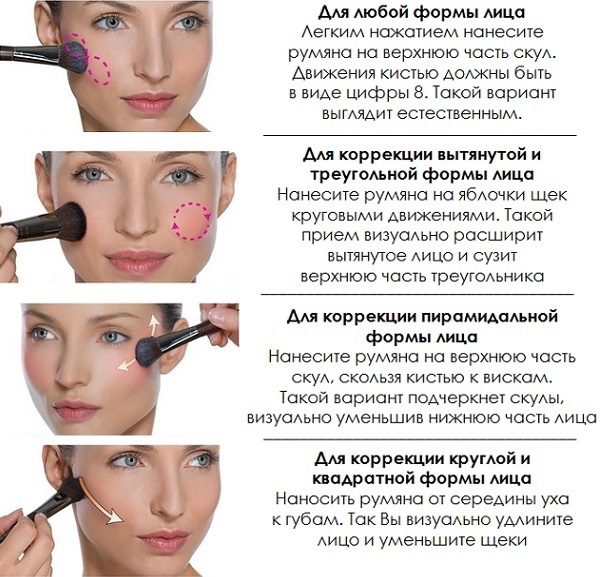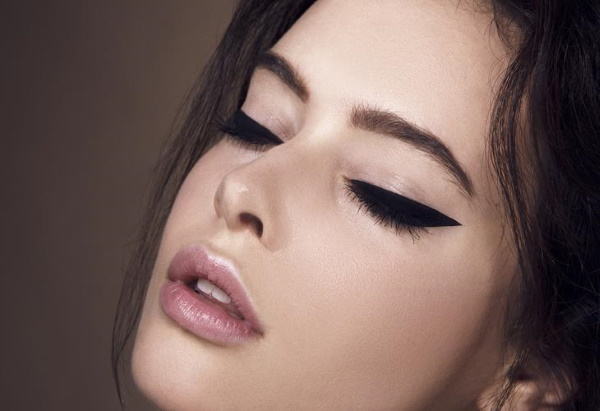As well as professional make-up, makeup for beginners, which can be applied every day without spending a lot of time, assumes adherence to the generally accepted algorithm.
Understanding the main stages of applying cosmetics, as well as knowing the most common mistakes made by beginners, will help the girl to competently hide the existing flaws in her appearance and emphasize the objective advantages.
What do you need to apply makeup?
Makeup for beginners for every day does not require a lot of professional cosmetics.
At first, you can get by with the basic set:
- makeup base (a product used for longer wearing makeup on the face);
- foundation, foundation or mattifying powder a light shade to even out skin tone;
- liquid or dry eyeshadow (the shade should be chosen taking into account the girl's eye color, as well as how she wants to look with makeup);
- blush (used to emphasize the natural blush on the girl's cheeks, as well as to visually transform the face with pronounced cheekbones);
- eyebrow shadow (alternatively, it is permissible to use an eyebrow pencil), used to outline the shape of the eyebrows and hide the uneven growth of hairs in the brow arches;
- pomade or, if the girl's appearance does not need a bright accent, a pastel lip gloss (using cosmetics for lips, you can not only make them brighter, but also visually correct the natural shape).
Despite the fact that the simplest make-up does not require a lot of cosmetics, the selected products of the beauty industry must be of high quality (premium hypoallergenic line of any brand is preferable).
Basic makeup rules
Daytime and evening make-up differ in the intensity of the tones of the cosmetics used, as well as the overall brightness of the final image. For a festive event, make-up artists recommend working in detail with each area of the face, correcting or emphasizing it (contouring).
A daily make-up requires only aligning the tone and then placing an emphasis on the merits of the girl's appearance (for example, if the girl has full lips, in everyday makeup it will be enough to put a tone on her face and paint her lips with bright lipstick).
In order for the makeup, which is planned to be worn for no particular reason, to succeed, the beginner should adhere to the basic rules structured by professional makeup artists.
They are:
- Before applying cosmetics, thoroughly cleanse the skin of dust accumulated on it with micellar water or tonic;
- the first layer is to apply a preparatory agent (base), which provides additional nutrition and protection of the skin from the negative effects of the components of the cosmetics used;
- if necessary, mask visible skin defects, use different shades of cosmetics for this purpose;
- to even out skin tone from the forehead, cheekbones, bridge of the nose and chin;
- after applying the tone, you should "fix" it with the help of powder, which also removes oily sheen;
- used "tools", for example, makeup brushes, must be cleaned at least once every 2 weeks (provided they are used daily);
- in the evenings, remove makeup with special products to avoid irritation and excessive dryness of the skin.
The sequence of applying cosmetics
It is recommended to create makeup for beginners for every day sequentially:
- Apply a moisturizer to a previously cleansed face.
- Cover the skin with a base or primer (to fix the make-up on the face and minimize the risk of oily sheen).
- Apply foundation evenly to face. To do this, you should use professional brushes or a beauty blender. Applying foundation to your face with your fingers may cause irritation or an allergic reaction.
- Apply a moisturizing colorless balm to the lips.
- Spot imperfections of the skin with special correctors, picking them up in tone depending on the color of the imperfection to which they will be applied.
- Cover under eye circles with a light concealer if necessary.
- Apply a primer on the eyelids (for longer wear of cosmetics).
- Look up or draw arrows.
- Decorate the ciliary rows: curl the eyelashes with tongs, paint with mascara and, if desired, glue bunches of artificial hairs.
- Fix the position of the hairs on the eyebrows after combing them.
- Apply blush on the protruding "apples" of the cheeks.
- Contour the lips with a pencil, adjusting their shape if necessary.
- Apply lipstick or lip gloss.
- Cover the skin with powder (to fix the previously applied makeup).
Makeup stages
Subject to the main stages of makeup, the cosmetics applied to the face will remain in their original form for 5-7 hours, without the need for adjustments.
Facial skin preparation
Everyday makeup for beginners should start with preparing the skin for the application of cosmetics.
For this it is recommended:
- Soak a cotton ball in tonic or micellar water. Wipe your face, carefully removing accumulated impurities from the skin.
- Using your fingers, apply a base moisturizer or serum evenly. Wait until the product is completely absorbed. If necessary, after 5-7 minutes, remove excess cream with a cotton pad.
- While the cream applied to the face dries, experienced makeup artists recommend using hydrogel eye patches with a moisturizing effect. After that, you should nourish the lips by distributing a colorless balm with herbal ingredients over their surface.
- Apply a serum to your face that matches your skin type. For example, for oily skin, it is recommended to use a sebum regulator; for dull and lifeless - a composition with shimmering particles; and for a long-term preservation of the original make-up type - serum made on the basis of silicone components.
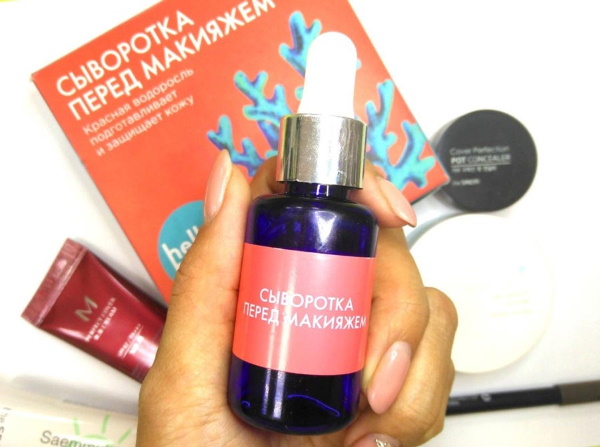
Skipping the preparatory stage in creating an image can lead not only to the fact that the cosmetics are smeared in certain places due to excessive sebum secretion, but also to the fact that irritation, peeling or an allergic reaction may appear in especially sensitive areas.
Masking problem areas
The 2nd stage of applying cosmetics is relevant for girls with problem skin (a tendency to rashes, irritation, and so on), as well as those on whose face there are scars, scratches or scars. In the absence of the above defects, this stage can be skipped.
If you need to minimize the appearance of red acne, you should use a green corrector (solid or liquid). When carefully rubbed into the skin, it "extinguishes" the saturation of rashes, visually making the complexion smoother.If you need to hide the veins, blue streaks or purple spots, we recommend using a yellow corrector.
It is advisable to use matting agents of pink or red color if the girl has an earthy, dark skin tone. For situations where you need to remove orange marks from unevenly distributed self-tanning to create an even tone, you can use a purple corrector.
To visually eliminate bruises or bags under the eyes, it is recommended to apply a thick concealer.
The wrong choice of shade of the corrector can lead not only to the fact that the skin defect cannot be hidden, but also to the fact that it becomes even more noticeable to others. It is necessary to choose products of this type in conjunction with a beautician, make-up artist or a consultant of a store specializing in beauty products.
Applying foundation
As a foundation for amateur makeup, you can use:
| Name of funds | Short description |
| Tone cream | It has a dense texture that evens out the overall complexion. It is not recommended for women with oily skin, as such a composition can clog pores, causing irritation or multiple rashes. |
| BB cream (similar bases - CC cream, mousse or the so-called fluid) | A product with the lightest texture that, after being applied to the surface of the skin, adjusts to its color. |
| Foundation or pressed powder | A dry composition, the color of which must exactly match the skin tone. Otherwise, after applying it, a clear border is formed between the face and the neck. |
It is recommended to apply the foundation not with your fingers, but with professional brushes, in the production of which synthetic fiber is used, or with a soft beauty blender, which can be used daily for no more than a 2-week period. With the help of a highlighter, you can lighten specific areas of the face, visually making it slimmer and more expressive.
Makeup artists recommend applying this composition to:
- whiskey;
- cheekbones;
- the bridge of the nose;
- superciliary areas.
Fixing the tone with powder
Makeup for beginners for every day will retain its original look longer if the applied foundation is fixed with powder. For this purpose, it is recommended to use a friable consistency of the product, since it will be easiest to evenly distribute such powder over the face.
To avoid the formation of a "mask effect", experienced makeup artists apply a dry composition for fixing exclusively on the T-zone, since it is she who is more prone to active sebum secretion. The T-zone covers the eyebrows and runs in a vertical line along the nose and skin areas above the upper and lower lips.
In the absence of the classic loose powder, a beginner can use:
- a transparent product for a similar purpose;
- white transparent powder.
Regardless of the type of composition chosen, it is important to remember that powder, as a fixing agent, should be applied with a fluffy professional brush in a minimum amount. If during the day its matting effect becomes insufficient, it is allowed to get wet your face with dry napkins.
Face correction with dry correctors
After a uniform complexion is achieved and fixed, make-up artists recommend correctly placing accents in the appearance with the help of dry correctors. Ignoring this stage will lead to the fact that the skin will be as lightened as possible, and natural dimples will be absent.
At the 1st stage it is necessary to darken the face contour:
- Use a medium flat brush to fill in a small amount of dark concealer.
- "Drive in" the dry composition on the hand, thus removing the excess from the brush.
- Brush under the cheekbones, then go to the hair growth zone.
- The final stage of working with a dark corrector will be the design of the sides of the nose, the area under the chin and above the lip.
The second stage of contouring involves highlighting specific areas of the face with a highlighter (light corrector), including:
- the back of the nose;
- depression above the upper lip;
- the chin;
- "Apples" on the cheeks;
- areas under the eyebrows;
- inner corners of the eyes;
- middle part of the forehead.
Eyebrow drawing
Drawing eyebrows is one of the most important stages of daily make-up, as it is it that allows you to emphasize the expressiveness of the eyes and make the face visually softer and more well-groomed.
This requires:
- Shape eyebrows with tweezers, removing hairs growing in unwanted areas.
- Brush eyebrows with a special brush, directing the hairs up.
- With a white or light pink eyeliner, outline the border under the eyebrow (the line should be as thin as possible). Shade.
- Using a beveled flat brush, apply a matte eyebrow shadow, adjusting the shape or thickness of the brow arches if necessary. If you don't have a special tapered brush, you can use a regular brush. In this case, it is necessary to carefully monitor the amount of the applied composition and the uniformity of its distribution, since in the presence of darker areas, the eyebrows will look asymmetrical.
- Brush eyebrows with a special brush.
- Lock the direction of hair growth with clear or brown eyebrow gel.
Eye makeup
Everyday makeup does not imply the obligatory eye shaping.
Despite this, it is important for novice makeup artists to know the generally accepted algorithm for applying shadows and creating arrows:
- Apply the base under the eyeshadow in an even layer on both eyelids, "driving" the composition into especially deep folds. The foundation allows the shadows to hold for a longer time without rubbing off or smudging.
- Apply a small amount of dark shadows (matte shadows preferred) to the outer corners of the eyes and the crease of the upper eyelid. If necessary, distribute the minimum amount of shadows along the lash line from the outer corner of the eye, then shade thoroughly.
- Shade light shadows in the area of the inner corners of the eye.
- Line up your eyes with a soft black pencil or eyeliner. This can be done by outlining the growth line of the eyelashes or by bringing the pencil out of the eyelid, thus creating an arrow.
- Apply a beige or light pink pencil on the upper mucous membrane of the lower eyelid.
- Apply mascara to the eyelashes, choosing a brush depending on the effect you plan to achieve during the final image creation.
Applying blush
Blush to create a daily look, you should choose a natural pinkish shade. Making a choice in favor of saturated colors of a dry composition, a girl runs the risk of giving her appearance vulgarity or curiosity.
The standard blush application algorithm consists of sequential steps:
- Stretch your lips into a smile.
- Apply a small amount of blush on a fluffy, large brush.
- Distribute the dry composition evenly on the "apples" of the cheeks (parts of the face that appear when smiling).
- Blend the blush, directing the brush towards the temples.
- To create an even tone and give the skin a healthy color, it is necessary to distribute the blush also on the tip of the nose and around the entire perimeter of the face.
It is not recommended to choose a blush of dubious composition, focusing on the fact that they will be in minimal contact with the skin of the face. Even a small amount of a poor-quality product can provoke the strongest irritation, which can only be eliminated with medication.
Lip makeup
For a daily look in lip makeup, you can use both lipstick and gloss (colorless or colored).
In order for the make-up made to retain its original appearance as long as possible, it is necessary:
- Apply foundation on lips evenly in a thin layer.
- Moisturize lips with a colorless balm.
- Draw the contour of the lips with a pencil of the same color as the lipstick. At this stage of applying cosmetics, you can visually correct the shape or fullness of the lips. If you need to make the lips plump, you need to draw the borders with a pencil, slightly deviating from the actual border of the real lips; to visually reduce the lips - the line, on the contrary, should pass along the actual border, slightly going beyond it onto the lips themselves.
- Paint over both lips completely with a pencil. Shade.
- Apply lipstick or colored lip gloss.
- If necessary, remove excess coloring cosmetics from the area around the mouth.
Make-up fixation
For the best fixation of the applied make-up, professional make-up artists recommend using a special fixative for cosmetics or ordinary thermal water, distributed over the skin with a spray bottle.
After applying the composition to the skin, you should wait until it is completely absorbed and only then go outside or put clothes over your head. Otherwise, loose cosmetics can not only smear, but also stain wardrobe items.
Major makeup mistakes
Skilled makeup artists recommend that beginners avoid the most common makeup mistakes:
- Using the wrong light when applying makeup. If the make-up is done in low light, going out into the light, the girl may find, for example, that the tonal base is unevenly distributed.
- Incorrectly selected shade of foundation.
- Excessive amounts of eye shadow or pencil applied to the eyebrows.
- Incorrectly chosen eyebrow shape. Too thin or, conversely, too thick.
- Using pearlescent shadows.
- Excessively long arrows on the eyes.
- Insufficient lip color saturation.
- Excessive amount of highlighter or dark concealer applied.
- Lack of contouring.
- Poorly shaded eyeshadow.
Even a novice makeup artist can create a beautiful makeup that is suitable for every day. For beginners, it is important to understand the algorithm for applying cosmetics, as well as how to fix its original appearance on the face. Knowing the most common mistakes in creating a make-up will help a girl look natural and beautiful, even with makeup on her face.
Article design:Lozinsky Oleg
Everyday makeup videos for beginners
Makeup master class for beginners:

